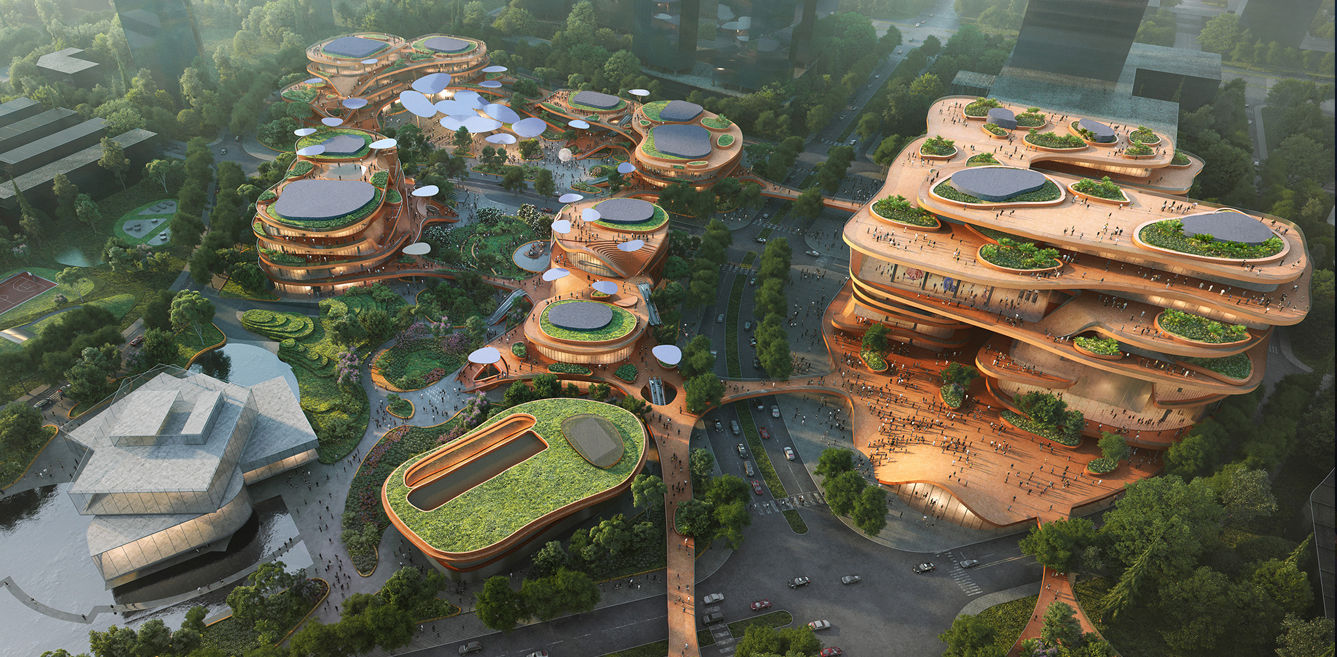

Shenzhen Terraces, a mixed-use hub, designed by MVRDV is characterised by a strong urban component with a series of terraced areas that aim to maximise public life and an abundance of green spaces.
The project that forms the core of the thriving university neighbourhood in Shenzhen’s Longgang District comprises a stack of accessible plates containing the buildings’ programme, where all communication takes place on the shaded terraces to maximise public life. Designed with sustainability as a focus, the project’s green outdoor spaces mix together with a wide variety of activities—including a theatre, a library, a museum, a conference centre and retail—to make the site a hub for meeting, learning, leisure, culture and relaxation. The stacked horizontal terraces provide a valuable contrast to the high-rise towers all around, but they also perform an ecological function: overhangs provide shade and the round shape promotes wind flow and natural ventilation. The abundance of greenery, pedestrian paths and water features make the project one of the most sustainable projects in Shenzhen.
Combining a pedestrian-friendly landscape with fewer than 20 different programmes including public transport, it is poised to become a sustainable hub for the surrounding area. The abundant planting and water features reduce the local temperature and provide habitat for urban wildlife, while gardens and rainwater collection generate food and water resources.
The edges of the terraces dip at strategic points to form connections between the various floors and to double as small outdoor auditoriums. In other places, the facades are pushed inwards to emphasize entrances and create recognizable places within the scheme to help visitors orient themselves. At the centre of the largest building, on the east of the site, the terraces curve inward to form an open-air atrium. In the buildings on the western side of the site, a new library concept defines the complex: rather than a separate entity, the library acts as the glue, divided over two buildings and connecting related educational and commercial programmes such as a Youth Activity Centre and a Youth Entrepreneurship Centre, with a ‘books park’ outside. The bridges connect the buildings to turn the second floor into a continuous route and connect the terraces with surrounding developments.
An important ambition for the project was to merge the building with the landscape and make the project as sustainable as possible. The landscaping, developed in collaboration with Openfabric, adds patches of jungle-like greenery and public programming between pedestrian routes. These patches host planting that imitates the sub-tropical natural forests of the region, mixed alongside features such as grassy hills, public art, reflective pools and activity zones for climbing or table tennis. The roofs are also part of this landscape, used not only for photovoltaic panels and rainwater collection but also large, accessible green lawns.
“In cities like Shenzhen, it is essential to think carefully about how public space and the natural landscape can be integrated into a dense city. Cool spaces, sheltered from the weather, create an escape from air-conditioned interiors”, said MVRDV founding partner Winy Maas. “Shenzhen Terraces can be seen as a three-dimensional park that makes it possible for students to walk outside to their lectures in the warm weather instead of being locked inside. In this project we are not working against the climate, but with the climate. The naturally ventilated terraces, protected from the sun by overhangs, will soon become fantastic hangout spots for people to meet and study.”
Image credit: © Atchain
Factfile
Project: Shenzhen Terraces, China
Architects: MVRDV
Client: Shenzhen Shimao Xin Li Cheng Industry Co.,Ltd.
Founding partner in-charge: Winy Maas
Director: Gideon Maasland
Associate design director: Gijs Rikken
Design team: Sanne van Manen, Irgen Salianji, Shengjie Zhan, Luca Beltrame, Katarzyna Maria Ephraim, Cas Esbach, Hengwei Ji, DongMin Lee, Yannick Macken, Giuseppe Mazzaglia, Siyi Pan, Sen Yang, Jiani You, Daan Zandbergen
Partners – landscape architect: Openfabric; Cost Calculation: Shanghai Xinyuan Construction Engineering Consulting Co., Ltd
Size and programme: 95,000 m2 mixed-use
Year of completion: 2019
Copyright: MVRDV 2018
(Winy Maas, Jacob van Rijs, Nathalie de Vries)
The architectural landscape of Rajasthan is steeped in a rich tradition of historic masonry, reflecting…
Are you a corporate employee spending 10+ hours in an ordinary cubicle that's fused in…
Modern Indian homes are no longer bound by their physical vicinity. They have outgrown our…
Häcker Kitchens, a brand synonymous with quality and innovation, has a rich legacy that spans…
In this home designed by Sonal R Mutha and Aniketh Bafna, founders and principal designers…
Essentia Home’s journey in redefining luxury interiors took a bold new step as it opened…